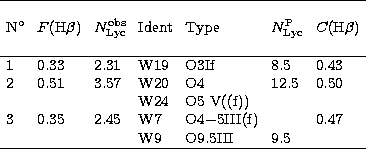Absolute H![]() photometry observations (Caplan
photometry observations (Caplan ![]() Deharveng 1985) in an aperture
of 4.9
Deharveng 1985) in an aperture
of 4.9![]() give an H
give an H![]() flux of LH 101 equivalent to a number of Lyman
continuum photons per second (
flux of LH 101 equivalent to a number of Lyman
continuum photons per second (![]() ) of 112 1048 photons/s
(Devereux & Scowen 1994) and corresponding to
) of 112 1048 photons/s
(Devereux & Scowen 1994) and corresponding to ![]() 3 OV stars
(Panagia 1973).
The number of Lyman continuum photons derived from our quasi complete O star content
of LH 101 (
3 OV stars
(Panagia 1973).
The number of Lyman continuum photons derived from our quasi complete O star content
of LH 101 (![]() ) (Table 5) in the same area (Fig. 3) is found to be larger
(
) (Table 5) in the same area (Fig. 3) is found to be larger
(![]() ph/s ) corresponding to
ph/s ) corresponding to ![]() 10 OV.
10 OV.
As seen in Fig. 3, the HII region is composed of three distinct zones.
Using a few IDS nebular spectra of bright regions of LH 101 obtained
with the ESO 1.5-m telescope in 1984, and our monochromatic CCD H![]() image (Fig. 3), we calibrated each zone in flux F(H
image (Fig. 3), we calibrated each zone in flux F(H![]() ) (Table 5).
) (Table 5).
We notice that as well in each HII zone as in the whole HII region,
the ![]() derived from the O stars is greater than
derived from the O stars is greater than ![]() derived from the observed H
derived from the observed H![]() or H
or H![]() flux by a factor 3-4.
This discrepancy could be both attributed to inhomogeneity in the gas
that would let escape Lyman continuum photons and to dust obscuration
sensitive to H
flux by a factor 3-4.
This discrepancy could be both attributed to inhomogeneity in the gas
that would let escape Lyman continuum photons and to dust obscuration
sensitive to H![]() (Caldwell
(Caldwell ![]() Kutner 1996). The reality of this
density inhomogeneity is a basic property of young HII regions. Here we
notice that the stellar population is strongly different in the S-E active
HII region populated by unevolved O stars, and in the N-W and towards
LH 104 where stellar winds probably have dispersed the interstellar matter.
Kutner 1996). The reality of this
density inhomogeneity is a basic property of young HII regions. Here we
notice that the stellar population is strongly different in the S-E active
HII region populated by unevolved O stars, and in the N-W and towards
LH 104 where stellar winds probably have dispersed the interstellar matter.
 Notes to Table 5:
Notes to Table 5:
Column 1, 2: Zone numbering , F(H |
Copyright The European Southern Observatory (ESO)